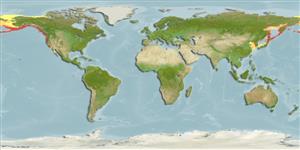Common names from other countries
>
Perciformes/Zoarcoidei (Eelpouts and pricklebacks) >
Anarhichadidae (Wolffishes)
Etymology: Anarrhichthys: Greek, anarhichaomai = to climb up + Greek, ichthys = fish; ocellatus: ocellatus for the eye-like spots..
More on author: Ayres.
Environment: milieu / climate zone / depth range / distribution range
Sinh thái học
Biển gần đáy; Mức độ sâu 1 - 226 m (Ref. 2850). Temperate; 80°N - 26°N, 117°E - 111°W (Ref. 57366)
North Pacific: Sea of Okhotsk and the Sea of Japan to the Krenitzen Islands, in the Aleutian chain and Imperial Beach, southern California, USA.
Bộ gần gũi / Khối lượng (Trọng lượng) / Age
Maturity: Lm ? range ? - ? cm
Max length : 240 cm TL con đực/không giới tính; (Ref. 4925); Khối lượng cực đại được công bố: 18.4 kg (Ref. 27436)
Tia cứng vây hậu môn: 0; Tia mềm vây hậu môn: 200. Dorsal with 228-250 spines. Caudal small. Anal with up to 233 rays.
Adults seek shelter among rocks in subtidal areas (Ref. 2850) and will occupy the same shelter until driven out by larger wolf-eels or a large octopus (Ref. 28499). Juveniles are pelagic for up to two years (Ref. 28499). Feed on hard-shelled invertebrates and fishes (Ref. 2850). Both male and female wrap their body around the egg mass to keep the eggs in place and to deter predators (Ref. 58332). Large specimens can inflict a painful bite (Ref. 28499). Its flesh is tasty (Ref. 28499).
When courting, the male wolf-eel butts his head against the female's abdomen, wraps around her, and fertilizes her eggs as she extrudes them. Eggs are laid and both male and female wrap themselves around the egg mass to protect it . Only one parent at a time leaves the eggs to feed. The female periodically rotates the eggs until they hatch. A male and female may pair for life (Ref. 28499).
Eschmeyer, W.N., E.S. Herald and H. Hammann, 1983. A field guide to Pacific coast fishes of North America. Boston (MA, USA): Houghton Mifflin Company. xii+336 p. (Ref. 2850)
IUCN Red List Status (Ref. 130435)
CITES (Ref. 128078)
Not Evaluated
Threat to humans
Traumatogenic (Ref. 2850)
Human uses
Các nghề cá: buôn bán nhỏ; Bể nuôi cá: Bể cá công cộng
Các công cụ
Special reports
Download XML
Các nguồn internet
Estimates based on models
Preferred temperature (Ref.
115969): 1.2 - 10.5, mean 4.7 (based on 485 cells).
Phylogenetic diversity index (Ref.
82804): PD
50 = 1.0312 [Uniqueness, from 0.5 = low to 2.0 = high].
Bayesian length-weight: a=0.00398 (0.00174 - 0.00913), b=3.17 (2.97 - 3.37), in cm Total Length, based on LWR estimates for this (Sub)family-body shape (Ref.
93245).
Mức dinh dưỡng (Ref.
69278): 3.5 ±0.53 se; based on food items.
Thích nghi nhanh (Ref.
120179): thấp, thời gian nhân đôi của chủng quần tối thiểu là 4.5 - 14 năm (tm=7; Fec=10,000).
Fishing Vulnerability (Ref.
59153): Very high vulnerability (90 of 100).
